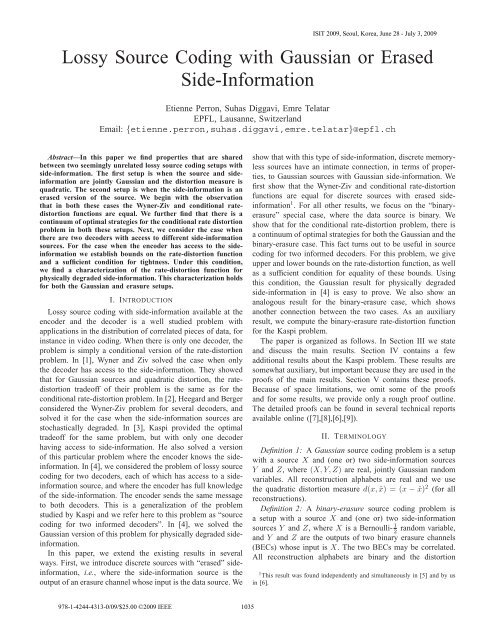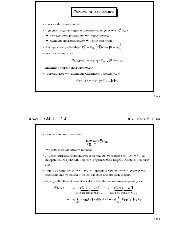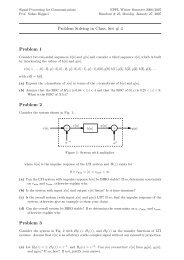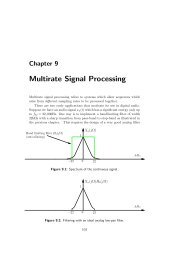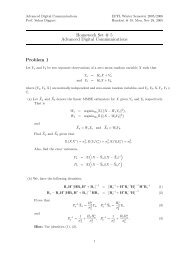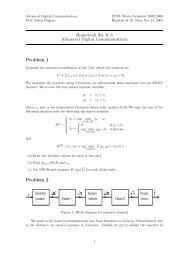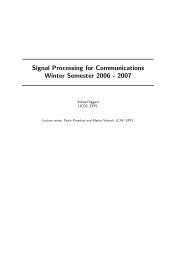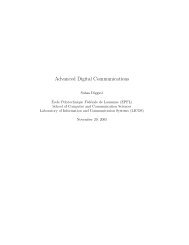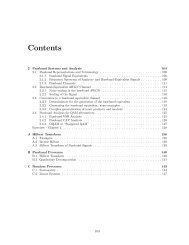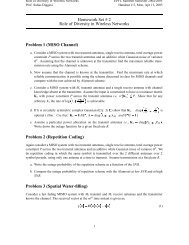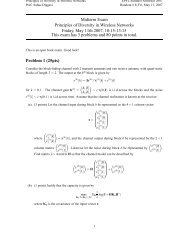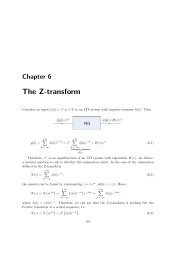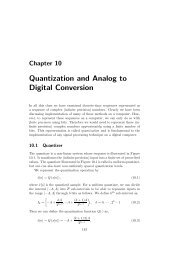Lossy Source Coding with Gaussian or Erased Side-Information
Lossy Source Coding with Gaussian or Erased Side-Information
Lossy Source Coding with Gaussian or Erased Side-Information
You also want an ePaper? Increase the reach of your titles
YUMPU automatically turns print PDFs into web optimized ePapers that Google loves.
<strong>Lossy</strong> <strong>Source</strong> <strong>Coding</strong> <strong>with</strong> <strong>Gaussian</strong> <strong>or</strong> <strong>Erased</strong><br />
<strong>Side</strong>-Inf<strong>or</strong>mation<br />
Etienne Perron, Suhas Diggavi, Emre Telatar<br />
EPFL, Lausanne, Switzerland<br />
Email: {etienne.perron,suhas.diggavi,emre.telatar}@epfl.ch<br />
Abstract—In this paper we find properties that are shared<br />
between two seemingly unrelated lossy source coding setups <strong>with</strong><br />
side-inf<strong>or</strong>mation. The first setup is when the source and sideinf<strong>or</strong>mation<br />
are jointly <strong>Gaussian</strong> and the dist<strong>or</strong>tion measure is<br />
quadratic. The second setup is when the side-inf<strong>or</strong>mation is an<br />
erased version of the source. We begin <strong>with</strong> the observation<br />
that in both these cases the Wyner-Ziv and conditional ratedist<strong>or</strong>tion<br />
functions are equal. We further find that there is a<br />
continuum of optimal strategies f<strong>or</strong> the conditional rate dist<strong>or</strong>tion<br />
problem in both these setups. Next, we consider the case when<br />
there are two decoders <strong>with</strong> access to different side-inf<strong>or</strong>mation<br />
sources. F<strong>or</strong> the case when the encoder has access to the sideinf<strong>or</strong>mation<br />
we establish bounds on the rate-dist<strong>or</strong>tion function<br />
and a sufficient condition f<strong>or</strong> tightness. Under this condition,<br />
we find a characterization of the rate-dist<strong>or</strong>tion function f<strong>or</strong><br />
physically degraded side-inf<strong>or</strong>mation. This characterization holds<br />
f<strong>or</strong> both the <strong>Gaussian</strong> and erasure setups.<br />
I. INTRODUCTION<br />
<strong>Lossy</strong> source coding <strong>with</strong> side-inf<strong>or</strong>mation available at the<br />
encoder and the decoder is a well studied problem <strong>with</strong><br />
applications in the distribution of c<strong>or</strong>related pieces of data, f<strong>or</strong><br />
instance in video coding. When there is only one decoder, the<br />
problem is simply a conditional version of the rate-dist<strong>or</strong>tion<br />
problem. In [1], Wyner and Ziv solved the case when only<br />
the decoder has access to the side-inf<strong>or</strong>mation. They showed<br />
that f<strong>or</strong> <strong>Gaussian</strong> sources and quadratic dist<strong>or</strong>tion, the ratedist<strong>or</strong>tion<br />
tradeoff of their problem is the same as f<strong>or</strong> the<br />
conditional rate-dist<strong>or</strong>tion problem. In [2], Heegard and Berger<br />
considered the Wyner-Ziv problem f<strong>or</strong> several decoders, and<br />
solved it f<strong>or</strong> the case when the side-inf<strong>or</strong>mation sources are<br />
stochastically degraded. In [3], Kaspi provided the optimal<br />
tradeoff f<strong>or</strong> the same problem, but <strong>with</strong> only one decoder<br />
having access to side-inf<strong>or</strong>mation. He also solved a version<br />
of this particular problem where the encoder knows the sideinf<strong>or</strong>mation.<br />
In [4], we considered the problem of lossy source<br />
coding f<strong>or</strong> two decoders, each of which has access to a sideinf<strong>or</strong>mation<br />
source, and where the encoder has full knowledge<br />
of the side-inf<strong>or</strong>mation. The encoder sends the same message<br />
to both decoders. This is a generalization of the problem<br />
studied by Kaspi and we refer here to this problem as “source<br />
coding f<strong>or</strong> two inf<strong>or</strong>med decoders”. In [4], we solved the<br />
<strong>Gaussian</strong> version of this problem f<strong>or</strong> physically degraded sideinf<strong>or</strong>mation.<br />
In this paper, we extend the existing results in several<br />
ways. First, we introduce discrete sources <strong>with</strong> “erased” sideinf<strong>or</strong>mation,<br />
i.e., where the side-inf<strong>or</strong>mation source is the<br />
output of an erasure channel whose input is the data source. We<br />
show that <strong>with</strong> this type of side-inf<strong>or</strong>mation, discrete mem<strong>or</strong>yless<br />
sources have an intimate connection, in terms of properties,<br />
to <strong>Gaussian</strong> sources <strong>with</strong> <strong>Gaussian</strong> side-inf<strong>or</strong>mation. We<br />
first show that the Wyner-Ziv and conditional rate-dist<strong>or</strong>tion<br />
functions are equal f<strong>or</strong> discrete sources <strong>with</strong> erased sideinf<strong>or</strong>mation<br />
1 . F<strong>or</strong> all other results, we focus on the “binaryerasure”<br />
special case, where the data source is binary. We<br />
show that f<strong>or</strong> the conditional rate-dist<strong>or</strong>tion problem, there is<br />
a continuum of optimal strategies f<strong>or</strong> both the <strong>Gaussian</strong> and the<br />
binary-erasure case. This fact turns out to be useful in source<br />
coding f<strong>or</strong> two inf<strong>or</strong>med decoders. F<strong>or</strong> this problem, we give<br />
upper and lower bounds on the rate-dist<strong>or</strong>tion function, as well<br />
as a sufficient condition f<strong>or</strong> equality of these bounds. Using<br />
this condition, the <strong>Gaussian</strong> result f<strong>or</strong> physically degraded<br />
side-inf<strong>or</strong>mation in [4] is easy to prove. We also show an<br />
analogous result f<strong>or</strong> the binary-erasure case, which shows<br />
another connection between the two cases. As an auxiliary<br />
result, we compute the binary-erasure rate-dist<strong>or</strong>tion function<br />
f<strong>or</strong> the Kaspi problem.<br />
The paper is <strong>or</strong>ganized as follows. In Section III we state<br />
and discuss the main results. Section IV contains a few<br />
additional results about the Kaspi problem. These results are<br />
somewhat auxiliary, but imp<strong>or</strong>tant because they are used in the<br />
proofs of the main results. Section V contains these proofs.<br />
Because of space limitations, we omit some of the proofs<br />
and f<strong>or</strong> some results, we provide only a rough proof outline.<br />
The detailed proofs can be found in several technical rep<strong>or</strong>ts<br />
available online ([7],[8],[6],[9]).<br />
II. TERMINOLOGY<br />
Definition 1: A <strong>Gaussian</strong> source coding problem is a setup<br />
<strong>with</strong> a source X and (one <strong>or</strong>) two side-inf<strong>or</strong>mation sources<br />
Y and Z, where (X,Y,Z) are real, jointly <strong>Gaussian</strong> random<br />
variables. All reconstruction alphabets are real and we use<br />
the quadratic dist<strong>or</strong>tion measure d(x, ˆx) = (x − ˆx) 2 (f<strong>or</strong> all<br />
reconstructions).<br />
Definition 2: A binary-erasure source coding problem is<br />
a setup <strong>with</strong> a source X and (one <strong>or</strong>) two side-inf<strong>or</strong>mation<br />
sources Y and Z, where X is a Bernoulli- 1 2<br />
random variable,<br />
and Y and Z are the outputs of two binary erasure channels<br />
(BECs) whose input is X. The two BECs may be c<strong>or</strong>related.<br />
All reconstruction alphabets are binary and the dist<strong>or</strong>tion<br />
1 This result was found independently and simultaneously in [5] and by us<br />
in [6].
measure is the Hamming distance d(x, ˆx) = x ⊕ ˆx (f<strong>or</strong> all<br />
reconstructions), where ⊕ denotes modulo-2 addition over the<br />
binary field.<br />
Definition 3: F<strong>or</strong> a given source coding problem, the ratedist<strong>or</strong>tion<br />
function expresses the smallest rate f<strong>or</strong> which the<br />
rate dist<strong>or</strong>tion pair (<strong>or</strong> triple) is achievable f<strong>or</strong> the given<br />
dist<strong>or</strong>tion(s).<br />
III. MAIN RESULTS<br />
The five the<strong>or</strong>ems contained in this section constitute the<br />
main results of this paper. All the results hold in an analogous<br />
way f<strong>or</strong> both the binary-erasure and the <strong>Gaussian</strong> case, hence<br />
demonstrating the connection between the two cases. To the<br />
best of our knowledge, all the results in this section are<br />
new, <strong>with</strong> the exception of The<strong>or</strong>em 1 which was found<br />
independently and simultaneously in [5] and in [6]. Also, the<br />
<strong>Gaussian</strong> part of The<strong>or</strong>em 5 was already published in [4].<br />
A. One Decoder<br />
To convince the reader how similar the binary-erasure and<br />
the <strong>Gaussian</strong> setups are, we first state two imp<strong>or</strong>tant results f<strong>or</strong><br />
the case when there is only one decoder. It is well-known that<br />
in the <strong>Gaussian</strong> case, the rate-dist<strong>or</strong>tion function f<strong>or</strong> a single<br />
decoder <strong>with</strong> side-inf<strong>or</strong>mation is<br />
R X|Y (D) = R WZ (D) = 1 Var (X|Y )<br />
log ,<br />
2 D<br />
no matter whether Y is available at the encoder <strong>or</strong> not. We<br />
find that f<strong>or</strong> the erasure case, a similar property holds:<br />
The<strong>or</strong>em 1: When X is a source taking values in a discrete<br />
set X and Y is an erased version of X, i.e.,<br />
{ X w.p. 1 − p<br />
Y =<br />
ǫ w.p. p,<br />
then we have the following: Provided that the reconstruction<br />
alphabet is X and the dist<strong>or</strong>tion measure d : X × X → R +<br />
is such that d(x,x) = 0 f<strong>or</strong> all x ∈ X , the rate-dist<strong>or</strong>tion<br />
function f<strong>or</strong> a single decoder <strong>with</strong> side-inf<strong>or</strong>mation is<br />
R X|Y (D) = R WZ (D) = pR X (D/p),<br />
no matter whether Y is available at the encoder <strong>or</strong> not.<br />
Here, R X (·) is the rate-dist<strong>or</strong>tion function of the source X<br />
under the dist<strong>or</strong>tion measure d, when the decoder has no sideinf<strong>or</strong>mation.<br />
To the best of our knowledge, there is no other<br />
case in which the conditional and Wyner-Ziv rate-dist<strong>or</strong>tion<br />
functions match f<strong>or</strong> a discrete source. The proof of The<strong>or</strong>em<br />
1 can be found in the appendix of a technical rep<strong>or</strong>t [6]. Note<br />
that The<strong>or</strong>em 1 holds f<strong>or</strong> arbitrary, discrete sources. In the<br />
rest of this paper, we focus on binary-erasure problems, where<br />
the source X takes values in {0,1}. In this case, The<strong>or</strong>em 1<br />
becomes:<br />
C<strong>or</strong>ollary 1: F<strong>or</strong> the binary-erasure source coding problem<br />
<strong>with</strong> one decoder and only one side-inf<strong>or</strong>mation Y , we have<br />
R X|Y (D) = R WZ (D) = p(1 − h(D/p)),<br />
where h(·) is the binary entropy function.<br />
When the encoder knows the side-inf<strong>or</strong>mation, one can<br />
either use the conditional rate-dist<strong>or</strong>tion scheme <strong>or</strong> the Wyner-<br />
Ziv scheme, which is also applicable because the encoder<br />
can ign<strong>or</strong>e the side-inf<strong>or</strong>mation. Our second result f<strong>or</strong> one<br />
decoder shows that there are actually infinitely many different<br />
schemes who are all optimal in this case. The conditional<br />
rate-dist<strong>or</strong>tion function can be written as R X|Y (D) =<br />
min pW |X,Y<br />
(<br />
I(X,Y ;W) − I(W;Y )<br />
)<br />
, where W takes values<br />
in the reconstruction alphabet, and p W |X,Y is such that the<br />
dist<strong>or</strong>tion requirement can be satisfied by some estimat<strong>or</strong><br />
ˆX = g(W,Y ).<br />
The<strong>or</strong>em 2: F<strong>or</strong> the <strong>Gaussian</strong> case and the binary-erasure<br />
case, R X|Y (D) can be achieved by a continuum of auxiliary<br />
random variables W (taking values in the reconstruction alphabet<br />
R and {0,1}), <strong>with</strong> I(W;Y ) varying in [0, ∞] and [0,1−p]<br />
f<strong>or</strong> the <strong>Gaussian</strong> and the binary-erasure case, respectively.<br />
The proof of The<strong>or</strong>em 2 can be found in Section V.<br />
Remark 1: When I(W;Y ) = 0, then W c<strong>or</strong>responds to a lossy<br />
description of the “innovation”, i.e., of the quantity X −f(Y ),<br />
where f(Y ) is the best estimat<strong>or</strong> of X from Y .<br />
Remark 2: The continuum contains one choice of W f<strong>or</strong><br />
which W −◦ X −◦ Y is a Markov chain. This choice of<br />
W c<strong>or</strong>responds to the Wyner-Ziv scheme [1].<br />
B. Two Inf<strong>or</strong>med Decoders<br />
Consider now the rate-dist<strong>or</strong>tion setup depicted in Figure<br />
1. The source X is to be described at dist<strong>or</strong>tion D 1 and<br />
D 2 , respectively to two decoders who have access to different<br />
side-inf<strong>or</strong>mation sources Y and Z, respectively. Both<br />
Y and Z are also available at the encoder. We refer to<br />
this problem as “source coding f<strong>or</strong> two inf<strong>or</strong>med decoders”,<br />
and we denote the c<strong>or</strong>responding rate-dist<strong>or</strong>tion function by<br />
R(D 1 ,D 2 ). In the following, we present an upper and a lower<br />
Y<br />
X<br />
Z<br />
Fig. 1.<br />
Encoder<br />
Decoder 1<br />
Decoder 2<br />
ˆX 1<br />
ˆX 2<br />
<strong>Source</strong> coding f<strong>or</strong> two inf<strong>or</strong>med decoders.<br />
bound on R(D 1 ,D 2 ), a sufficient condition f<strong>or</strong> equality of the<br />
bounds, and we show that this condition holds when the sideinf<strong>or</strong>mation<br />
is physically degraded. All of these results are<br />
valid f<strong>or</strong> both the binary-erasure and the <strong>Gaussian</strong> case.<br />
In [4], we presented an achievable rate-dist<strong>or</strong>tion region<br />
f<strong>or</strong> the problem of source coding f<strong>or</strong> two inf<strong>or</strong>med decoders<br />
when (X,Y,Z) is a general discrete mem<strong>or</strong>yless multisource<br />
(The<strong>or</strong>em 1 of that publication). F<strong>or</strong> the <strong>Gaussian</strong> and binaryerasure<br />
versions of the problem, we simplify that region by<br />
dropping the auxiliary random variables U and V . The result<br />
is the following upper bound on the rate-dist<strong>or</strong>tion function,<br />
stated as a c<strong>or</strong>ollary to The<strong>or</strong>em 1 in [4]:
C<strong>or</strong>ollary 2: In the <strong>Gaussian</strong> and the binary-erasure case,<br />
the rate-dist<strong>or</strong>tion function f<strong>or</strong> two inf<strong>or</strong>med decoders<br />
R(D 1 ,D 2 ) is upper bounded by<br />
R + (D 1 ,D 2 ) =<br />
min max{ I(X,Y ;W |Z),<br />
p W |XY Z ∈A(D 1,D 2)<br />
I(X,Z;W |Y ) } (1)<br />
where A(D 1 ,D 2 ) is the set of all conditional distributions of<br />
random variables W such that<br />
• W is <strong>Gaussian</strong> <strong>or</strong> binary symmetric, respectively, and<br />
jointly distributed <strong>with</strong> (X,Y,Z),<br />
• ∃ ˆX 1 (W,Y ) such that E [ d( ˆX 1 ,X) ] ≤ D 1 ,<br />
• ∃ ˆX 2 (W,Z) such that E [ d( ˆX 2 ,X) ] ≤ D 2 .<br />
Next, we provide a lower bound on R(D 1 ,D 2 ).<br />
The<strong>or</strong>em 3: In the <strong>Gaussian</strong> and the binary-erasure case, the<br />
rate-dist<strong>or</strong>tion function f<strong>or</strong> two inf<strong>or</strong>med decoders R(D 1 ,D 2 )<br />
is lower bounded by<br />
{<br />
R − (D 1 ,D 2 ) =max<br />
min<br />
p W |XY Z ∈A(D 1,D 2)<br />
I(X,Y ;W |Z),<br />
}<br />
min I(X,Z;W |Y ) , (2)<br />
p W |XY Z ∈A(D 1,D 2)<br />
where A(D 1 ,D 2 ) is defined as in C<strong>or</strong>ollary 2.<br />
This lower bound is obtained by assuming that a genie makes<br />
one of the side-inf<strong>or</strong>mation sources available to the decoder<br />
who does not know it, followed by additional steps. In [4], we<br />
developed a similar lower bound f<strong>or</strong> the <strong>Gaussian</strong> case. The<br />
proof of The<strong>or</strong>em 3 can be found in Section V.<br />
We find that in some cases, R − (D 1 ,D 2 ) and R + (D 1 ,D 2 )<br />
match, and in the next result, we provide a sufficient condition<br />
f<strong>or</strong> this equality.<br />
Definition 4: Let S ∗ ⊆ A(D 1 ,D 2 ) be the set of all optimizers<br />
of the first minimization in (2), i.e., p W ∗ |XY Z ∈ S ∗ if<br />
and only if<br />
I(X,Y ;W ∗ |Z) =<br />
min<br />
p W |XY Z ∈A(D 1,D 2)<br />
I(X,Y ;W |Z). (3)<br />
Similarly, let S ∗∗ be the set of all optimizers of the second<br />
minimization in (2).<br />
The<strong>or</strong>em 4: When I(W ∗ ;Z) ≤ I(W ∗ ;Y ) f<strong>or</strong> some<br />
p W ∗ |XY Z ∈ S ∗ <strong>or</strong> I(W ∗∗ ;Z) ≥ I(W ∗∗ ;Y ) f<strong>or</strong> some<br />
p W ∗∗ |XY Z ∈ S ∗∗ , then R + (D 1 ,D 2 ) = R − (D 1 ,D 2 ).<br />
The proof of The<strong>or</strong>em 4 can be found in Section V.<br />
This the<strong>or</strong>em is particularly useful to find an exact characterization<br />
of the rate-dist<strong>or</strong>tion function f<strong>or</strong> physically degraded<br />
side-inf<strong>or</strong>mation.<br />
Definition 5: In source coding f<strong>or</strong> two inf<strong>or</strong>med decoders,<br />
we say that the side-inf<strong>or</strong>mation is physically degraded if<br />
(X,Y,Z) f<strong>or</strong>ms a Markov chain in either of the <strong>or</strong>ders<br />
X −◦ Y −◦ Z <strong>or</strong> X −◦ Z −◦ Y .<br />
The<strong>or</strong>em 5: In source coding f<strong>or</strong> two inf<strong>or</strong>med encoders<br />
<strong>with</strong> physically degraded side-inf<strong>or</strong>mation, the rate-dist<strong>or</strong>tion<br />
function is R(D 1 ,D 2 ) = R + (D 1 ,D 2 ) f<strong>or</strong> both the <strong>Gaussian</strong><br />
and the binary-erasure case.<br />
This the<strong>or</strong>em generalizes a <strong>Gaussian</strong> result that was presented<br />
in [4]. A rather lengthy proof of that <strong>Gaussian</strong> result was<br />
provided in [8]. The novelty here is that the same result also<br />
holds f<strong>or</strong> the binary-erasure case, and that The<strong>or</strong>em 4 can be<br />
used to obtain a relatively simple proof f<strong>or</strong> both the <strong>Gaussian</strong><br />
and the binary-erasure case. The proof can be found in Section<br />
V.<br />
Application of The<strong>or</strong>em 2: In [8], we noted that if (X,Y )<br />
has the same statistics as (X,Z), then a Wyner-Ziv code,<br />
optimized f<strong>or</strong> the decoder <strong>with</strong> the m<strong>or</strong>e strict dist<strong>or</strong>tion<br />
requirement, is optimal. The<strong>or</strong>em 2 provides us <strong>with</strong> an<br />
interesting extension of this idea: Pick one of the two decoders,<br />
say Decoder 1, and implement a scheme that achieves the<br />
conditional rate-dist<strong>or</strong>tion function f<strong>or</strong> Decoder 1, R X|Y (D 1 ).<br />
Different random variables W out of the continuum described<br />
in The<strong>or</strong>em 2 are m<strong>or</strong>e <strong>or</strong> less useful f<strong>or</strong> Decoder 2, i.e., f<strong>or</strong><br />
estimating X from (W,Z). To find the best out of all the<br />
strategies that have rate R X|Y (D 1 ), one should find the W<br />
from the continuum that is most useful f<strong>or</strong> Decoder 2 and that<br />
satisfies I(W;Y ) ≤ I(W;Z). This last condition is required<br />
to ensure that although the encoder uses a binning scheme<br />
f<strong>or</strong> Decoder 1, Decoder 2 is also able to identify the c<strong>or</strong>rect<br />
member of the bin described by the message. A m<strong>or</strong>e detailed<br />
study of this technique is left as future w<strong>or</strong>k.<br />
Bound on the Gap: If we compare the upper and lower<br />
bounds given in C<strong>or</strong>ollary 2 and The<strong>or</strong>em 3, respectively,<br />
we notice that the only difference between upper and lower<br />
bound is that the minimization and the maximization are<br />
inverted. This fact can be used to bound the gap between<br />
the two bounds. F<strong>or</strong> instance, assume that I(X,Y ;W ∗ |Z) ≥<br />
I(X,Z;W ∗∗ |Y ), where W ∗ and W ∗∗ are as in Definition 4.<br />
Then,<br />
R + (D 1 ,D 2 ) − R − (D 1 ,D 2 )<br />
≤ max{I(X,Y ;W ∗ |Z),I(X,Z;W ∗ |Y )}<br />
− I(X,Y ;W ∗ |Z)<br />
= [ I(X,Z;W ∗ |Y ) − I(X,Y ;W ∗ |Z) ] +<br />
= [ I(W ∗ ;Z) − I(W ∗ ;Y ) ] +<br />
.<br />
IV. AUXILIARY RESULTS<br />
In [3], Kaspi found the rate-dist<strong>or</strong>tion function to a setup<br />
where a source X is encoded f<strong>or</strong> two decoders. One decoder<br />
has access to a side-inf<strong>or</strong>mation source Y , while the other<br />
decoder is uninf<strong>or</strong>med. The encoder knows Y . We call this<br />
problem the Kaspi problem. The Kaspi problem is a special<br />
case of source coding f<strong>or</strong> two inf<strong>or</strong>med decoders, in which<br />
one of the side-inf<strong>or</strong>mation sources is constant (Figure 1 <strong>with</strong><br />
Z = constant). The results in this section could be viewed<br />
as a special case of The<strong>or</strong>em 5. However, we present them<br />
as independent results, and we will use them in Section V to<br />
prove our main results, including The<strong>or</strong>em 5.<br />
In [4], we computed the rate-dist<strong>or</strong>tion function f<strong>or</strong> the<br />
<strong>Gaussian</strong> Kaspi problem. We repeat that result here:<br />
The<strong>or</strong>em 6: (The<strong>or</strong>em 2 in [4].) Let X ∼ N(0,σX 2 ), and<br />
Y = X + N, <strong>with</strong> N ∼ N(0,σN 2 ) independent of X. In the<br />
<strong>Gaussian</strong> Kaspi problem defined by these sources, the ratedist<strong>or</strong>tion<br />
function R Kaspi (D 1 ,D 2 ) is given by the following<br />
four regimes:
1) if D 1 ≥ σ2 X σ2 N<br />
σX 2 +σ2 N<br />
and D 2 ≥ σX 2 , then R Kaspi(D 1 ,D 2 ) = 0,<br />
2) if D 1 ≥ D2σ2 N<br />
D 2+σN<br />
2 and D 2 < σX 2 , then<br />
R Kaspi (D 1 ,D 2 ) = 1 2 log σ2 X<br />
D2<br />
,<br />
3) if D 1 < σ2 X σ2 N<br />
σX 2 +σ2 N<br />
R Kaspi (D 1 ,D 2 ) = 1 2 log<br />
and D 2 ≥ D 1 +<br />
σ 2 X σ2 N<br />
D 1(σ 2 X +σ2 N ),<br />
σ4 X<br />
σ 2 X +σ2 N<br />
4) otherwise, R Kaspi (D 1 ,D 2 ) = 1 2 log σ 2 X<br />
where ρ 0 =<br />
σ N(σ 2 X<br />
σ XD 1<br />
q<br />
Φ = D 2 (σX 2 − D 2) −<br />
Φ and<br />
−D1)D2<br />
s<br />
(σX<br />
2 D 2<br />
, then<br />
D 2(1−ρ 2 0 ),<br />
D 1<br />
(σ 2 N − D 1) − σ 2 N D 2)( D 2<br />
D 1<br />
− 1).<br />
The detailed proof of this the<strong>or</strong>em can be found in [7].<br />
It turns out that the binary-erasure Kaspi problem is very<br />
similar to its <strong>Gaussian</strong> counterpart. In particular, we have the<br />
following result:<br />
The<strong>or</strong>em 7: In the binary-erasure Kaspi problem, the ratedist<strong>or</strong>tion<br />
function R Kaspi (D 1 ,D 2 ) is given by the following<br />
four regimes (where p is the erasure probability of the BEC):<br />
1) if D 1 ≥ p 2 and D 2 ≥ 1 2 , then R Kaspi(D 1 ,D 2 ) = 0,<br />
2) if D 1 ≥ pD 2 and D 2 < 1 2 , then<br />
R Kaspi (D 1 ,D 2 ) = 1 − h(D 2 ),<br />
3) if D 1 < p 2 and D 2 ≥ D 1 + 1−p<br />
2 , then<br />
R Kaspi (D 1 ,D 2 ) = p ( 1 − h( D1<br />
p )) ,<br />
4) otherwise,<br />
R Kaspi (D 1 , D 2 ) = 1 − h`D 2 − D 1<br />
1 − p<br />
´<br />
+ p “h`D 2 − D 1<br />
1 − p<br />
´ 1 ´”<br />
− h`D<br />
.<br />
p<br />
The detailed proof of this the<strong>or</strong>em can be found in [6].<br />
C<strong>or</strong>ollary 3: In both the <strong>Gaussian</strong> case and the binaryerasure<br />
case, the rate-dist<strong>or</strong>tion function of the Kaspi problem<br />
is<br />
R Kaspi (D 1 ,D 2 ) = min<br />
p W |XY<br />
I(X,Y ;W),<br />
where the indicated minimization is over all auxiliary random<br />
variables W such that<br />
• W is <strong>Gaussian</strong> <strong>or</strong> binary symmetric, respectively, and<br />
jointly distributed <strong>with</strong> (X,Y ), [ ]<br />
• ∃ a function ˆX 1 (W,Y ) such that E<br />
• ∃ a function ˆX 2 (W) such that E<br />
d( ˆX 1 ,X) ≤ D 1 ,<br />
]<br />
≤ D 2 .<br />
[<br />
d( ˆX 2 ,X)<br />
The proof of this c<strong>or</strong>ollary is given in the appendix of [9].<br />
V. PROOFS OF THE MAIN RESULTS<br />
A. Sketch of the proof of The<strong>or</strong>em 2<br />
In the <strong>Gaussian</strong> case, W can be parametrized by 3 real<br />
parameters. Since scaling of W by a constant changes neither<br />
the rate n<strong>or</strong> the dist<strong>or</strong>tion, 2 relevant paremeters remain.<br />
However, since I(X;W |Y ) = 1 2<br />
, we see<br />
that any choice of W that satisfies Var(X|W,Y ) = D is<br />
optimal. After imposing this constraint, one of the parameters<br />
that specify W is still free, hence the continuum. In the<br />
binary-erasure case, W can be parametrized by 2 crossoverprobabilities<br />
connecting X and W (f<strong>or</strong> the two cases when Y<br />
is an erasure <strong>or</strong> not). It is clear that when Y is not an erasure,<br />
i.e., when Y = X, the best estimate of X given (W,Y ) should<br />
log<br />
Var(X|Y )<br />
Var(X|W,Y )<br />
be Y . Hence, one of the two parameters has no imp<strong>or</strong>tance<br />
in computing the expected dist<strong>or</strong>tion achieved by the optimal<br />
scheme. In addition, the same parameter plays no role in the<br />
rate expression I(X;W |Y ), either. Hence the continuum.<br />
B. Proof of The<strong>or</strong>em 3<br />
If a genie makes Z available to Decoder 1, we obtain a new<br />
setup that we call the “conditional Kaspi setup”. In this new<br />
setup, Decoder 1 is m<strong>or</strong>e powerful than bef<strong>or</strong>e, and hence, the<br />
rate-dist<strong>or</strong>tion function of the conditional Kaspi setup gives a<br />
lower bound on R(D 1 ,D 2 ).<br />
Note that in the conditional Kaspi setup, all three entities<br />
have access to Z. Hence, the problem is the same as the<br />
Kaspi problem f<strong>or</strong> sources ( ˜X,Ỹ ) that c<strong>or</strong>respond to “(X,Y )<br />
conditioned on Z”.<br />
From C<strong>or</strong>ollary 3, we conclude that the rate-dist<strong>or</strong>tion<br />
function of the conditional Kaspi problem can be written as<br />
R − Z (D 1,D 2 ) =<br />
min I(X,Y ;W |Z), (4)<br />
p W |XY Z ∈B(D 1,D 2)<br />
where B(D 1 ,D 2 ) is the set of all conditional distributions of<br />
random variables W such that<br />
• W is <strong>Gaussian</strong> <strong>or</strong> binary symmetric, respectively, and<br />
jointly distributed <strong>with</strong> (X,Y,Z),<br />
• ∃ a function ˆX<br />
[<br />
1 (W,Y,Z) such that E d( ˆX<br />
]<br />
1 ,X) ≤ D 1 ,<br />
• ∃ a function ˆX<br />
[<br />
2 (W,Z) such that E d( ˆX<br />
]<br />
2 ,X) ≤ D 2 .<br />
We can apply the exact same reasoning also f<strong>or</strong> the case<br />
when the genie makes Y available to Decoder 2. In this case,<br />
we obtain a different lower bound on R(D 1 ,D 2 ), namely<br />
R − Y (D 1,D 2 ) =<br />
min I(X,Z;W |Y ),<br />
p W |XY Z ∈C(D 1,D 2)<br />
where C(D 1 ,D 2 ) is the symmetric counterpart of B(D 1 ,D 2 ).<br />
The following lemma provides a simplification of the lower<br />
bounds given so far.<br />
Lemma 1: In R − Z (D 1,D 2 ) and in R − Y (D 1,D 2 ), the sets<br />
B(D 1 ,D 2 ) and C(D 1 ,D 2 ) can both be replaced by<br />
A(D 1 ,D 2 ), <strong>with</strong>out changing the outcome of the optimizations.<br />
The proof of Lemma 1 can be found in the appendix of [9].<br />
By combining the two bounds R − Z (D 1,D 2 ) and R − Y (D 1,D 2 ),<br />
the claim of the the<strong>or</strong>em follows.<br />
C. Proof of The<strong>or</strong>em 4<br />
From (2), we know that<br />
R − Z(D 1, D 2) =<br />
min [I(X, Y, Z; W) − I(Z; W)] . (5)<br />
A(D 1 ,D 2 )<br />
is a lower bound on R(D 1 ,D 2 ). The upper bound (1), on the<br />
other hand, can be written as<br />
[<br />
R + (D 1 ,D 2 ) = min I(X,Y,Z;W)<br />
p W |XY Z ∈A(D 1,D 2)<br />
]<br />
− min{I(W;Z),I(W;Y )} . (6)
Let W ∗ be a random variable whose distribution is a minimizer<br />
of (5), and assume that I(W ∗ ;Z) ≤ I(W ∗ ;Y ) Then,<br />
R − (D 1 ,D 2 ) ≥ R − Z (D 1,D 2 )<br />
=I(X,Y,Z;W ∗ ) − I(Z;W ∗ )<br />
=I(X,Y,Z;W ∗ ) − min{I(W ∗ ;Z),I(W ∗ ;Y )}<br />
≥R + (D 1 ,D 2 )<br />
where we used (6) in the last inequality. From C<strong>or</strong>ollary 2<br />
and The<strong>or</strong>em 3, it is clear that R + (D 1 ,D 2 ) ≥ R − (D 1 ,D 2 ).<br />
Hence, R − (D 1 ,D 2 ) = R + (D 1 ,D 2 ).<br />
When I(W ∗∗ ;Z) ≥ I(W ∗∗ ;Y ), where W ∗∗ is as defined in<br />
Definition 4, an analogous argument holds, <strong>with</strong> R − Z (D 1,D 2 )<br />
replaced by R − Y (D 1,D 2 ).<br />
D. Proof of The<strong>or</strong>em 5<br />
We only prove the result f<strong>or</strong> the Markov chain X −◦<br />
Y −◦ Z. The proof f<strong>or</strong> the other Markov chain is analogous.<br />
<strong>Gaussian</strong> case: W.l.o.g., we can assume that X ∼ N(0,σX 2 ),<br />
Y = X+N 1 and Z = Y +N 2 , where N i ∼ N(0,σi 2 ), i = 1,2<br />
are <strong>Gaussian</strong> random variables, independent of X and of each<br />
other. We parametrize W as<br />
W = aX + bN 1 + cN 2 + ξ,<br />
where ξ ∼ N(0,1), and ξ is independent of everything else.<br />
Using Lagrange multipliers, we find that (3) is optimized by<br />
a W ∗ f<strong>or</strong> which c = 0. It follows that W ∗ −◦ (X,Y ) −◦ Z.<br />
This, together <strong>with</strong> Lemma 2 below and The<strong>or</strong>em 4, lets us<br />
conclude the <strong>Gaussian</strong> part of the the<strong>or</strong>em. Details regarding<br />
the computation of the Lagrange equations can be found in [8].<br />
Binary-erasure case: Let X be a Bernoulli random variable<br />
<strong>with</strong> mean 1 2<br />
. Let Y be the output of a BEC <strong>with</strong> erasure<br />
probability p 1 , when X is the input, and let Z be the output<br />
of a BEC <strong>with</strong> erasure probability p 2 , when Y is the input.<br />
Any Bernoulli- 1 2<br />
random variable W jointly distributed <strong>with</strong><br />
(X,Y,Z) can be expressed using three parameters (q,r,s):<br />
q = P(W ≠ X|Y ≠ ǫ,Z ≠ ǫ)<br />
r = P(W ≠ X|Y ≠ ǫ,Z = ǫ)<br />
s = P(W ≠ X|Y = ǫ,Z = ǫ).<br />
In other w<strong>or</strong>ds, depending on the values of (Y,Z), X is<br />
connected to W through one of three virtual BSC’s that have<br />
crossover probabilities q, r and s, respectively. Using the<br />
parameters (q,r,s), the objective function in (3) can be written<br />
as<br />
I(X,Y ;W |Z) =I(X,Y,Z;W) − I(W;Z)<br />
=H(W |Z) − H(W |X,Y,Z)<br />
=p 1 + (1 − p 1 )p 2<br />
− (1 − p 1 )p 2 h(r) − p 1 h(s), (7)<br />
where the last equality follows after the terms containing h(q)<br />
have cancelled out. The best estimate of X given (W,Y ) is<br />
simply ˆX = Y whenever Y ≠ ǫ and ˆX = W otherwise.<br />
Hence, the dist<strong>or</strong>tion constraint f<strong>or</strong> Decoder 1 is<br />
P( ˆX 1 ≠ X) = p 1 s ≤ D 1 . (8)<br />
Likewise, f<strong>or</strong> Decoder 2, we require<br />
P( ˆX 2 ≠ X) = p 1 s + (1 − p 1 )p 2 r ≤ D 2 . (9)<br />
The parameter q figures in none of (7), (8) and (9). Hence,<br />
q can be freely chosen in the optimization. In particular, one<br />
optimal solution to (3) is a W ∗ such that q = r ∗ , where<br />
(r ∗ ,s ∗ ) are the optimizers of (7) subject to the dist<strong>or</strong>tion<br />
constraints (8) and (9). F<strong>or</strong> that particular choice of q, we<br />
have W ∗ −◦ (X,Y ) −◦ Z. This, together <strong>with</strong> Lemma 2 and<br />
The<strong>or</strong>em 4, concludes the binary-erasure part of the the<strong>or</strong>em.<br />
Lemma 2: Let (W,X,Y,Z) be arbitrary random variables<br />
such that the two Markov chains W −◦ (X,Y ) −◦ Z and<br />
X −◦ Y −◦ Z are satisfied. Then, I(W;Z) ≤ I(W;Y ).<br />
The proof of this lemma is given in the appendix of [9].<br />
VI. CONCLUSION<br />
The binary-erasure setting is promising as a tool to analyze<br />
problems in source coding <strong>with</strong> side-inf<strong>or</strong>mation. All the<br />
results that we provide f<strong>or</strong> the <strong>Gaussian</strong> case hold in an<br />
analogous way f<strong>or</strong> the binary-erasure case. In addition, the<br />
binary-erasure case is often m<strong>or</strong>e easy to analyze. This is<br />
due to the fact that in the binary-erasure case, the sideinf<strong>or</strong>mation<br />
is either perfect <strong>or</strong> completely useless. The results<br />
here suggest that there may be m<strong>or</strong>e connections between the<br />
<strong>Gaussian</strong> and erasure setups and it is likely that one may<br />
find further analogies between them. Such connections may<br />
provide insights into previously unresolved questions.<br />
F<strong>or</strong> the problem of source coding f<strong>or</strong> two inf<strong>or</strong>med decoders,<br />
we intend to provide a m<strong>or</strong>e complete discussion on<br />
how to apply The<strong>or</strong>em 2 in future w<strong>or</strong>k.<br />
REFERENCES<br />
[1] A. Wyner and J. Ziv, “The rate-dist<strong>or</strong>tion function f<strong>or</strong> source coding <strong>with</strong><br />
side inf<strong>or</strong>mation at the decoder,” IEEE Trans. Inf<strong>or</strong>m. The<strong>or</strong>y, vol. 22,<br />
no. 1, Jan. 1976.<br />
[2] C. Heegard and T. Berger, “Rate dist<strong>or</strong>tion when side inf<strong>or</strong>mation may be<br />
absent,” IEEE Trans. Inf<strong>or</strong>m. The<strong>or</strong>y, vol. 31, no. 6, pp. 727–734, Nov.<br />
1985.<br />
[3] A. Kaspi, “Rate-dist<strong>or</strong>tion function when side-inf<strong>or</strong>mation may be present<br />
at the decoder,” IEEE Trans. Inf<strong>or</strong>m. The<strong>or</strong>y, vol. 40, no. 6, pp. 2031–<br />
2034, Nov. 1994.<br />
[4] E. Perron, S. Diggavi, and E. Telatar, “On the role of side-inf<strong>or</strong>mation in<br />
source coding f<strong>or</strong> multiple decoders,” in Proc. of the IEEE Int. Symposium<br />
on Inf<strong>or</strong>m. The<strong>or</strong>y, Seattle, USA, 2006.<br />
[5] S. Verdu and T. Weissman, “The inf<strong>or</strong>mation lost in erasures,” IEEE<br />
Trans. Inf<strong>or</strong>m. The<strong>or</strong>y, vol. 54, no. 11, pp. 5030–5058, Nov. 2008.<br />
[6] E. Perron, S. Diggavi, and E. Telatar, “The Kaspi rate-dist<strong>or</strong>tion problem<br />
<strong>with</strong> encoder side-inf<strong>or</strong>mation: Binary erasure case,” École Polytechnique<br />
Fédérale de Lausanne, Switzerland, Tech. Rep. LICOS-REPORT-2006-<br />
004, Nov. 2006, http://licos.epfl.ch/index.php?p=pubs&l=en.<br />
[7] ——, “The Kaspi rate-dist<strong>or</strong>tion problem <strong>with</strong> encoder sideinf<strong>or</strong>mation:<br />
<strong>Gaussian</strong> case,” École Polytechnique Fédérale de Lausanne,<br />
Switzerland, Tech. Rep. LICOS-REPORT-2005-001, Nov. 2005,<br />
http://licos.epfl.ch/index.php?p=pubs&l=en.<br />
[8] ——, “On the role of side-inf<strong>or</strong>mation in source coding f<strong>or</strong><br />
multiple decoders,” École Polytechnique Fédérale de Lausanne,<br />
Switzerland, Tech. Rep. LICOS-REPORT-2006-003, Aug. 2006,<br />
http://licos.epfl.ch/index.php?p=pubs&l=en.<br />
[9] ——, “<strong>Lossy</strong> source coding <strong>with</strong> gaussian <strong>or</strong> erased sideinf<strong>or</strong>mation,”<br />
École Polytechnique Fédérale de Lausanne,<br />
Switzerland, Tech. Rep. LICOS-REPORT-2009-001, Jan. 2009,<br />
http://licos.epfl.ch/index.php?p=pubs&l=en.


